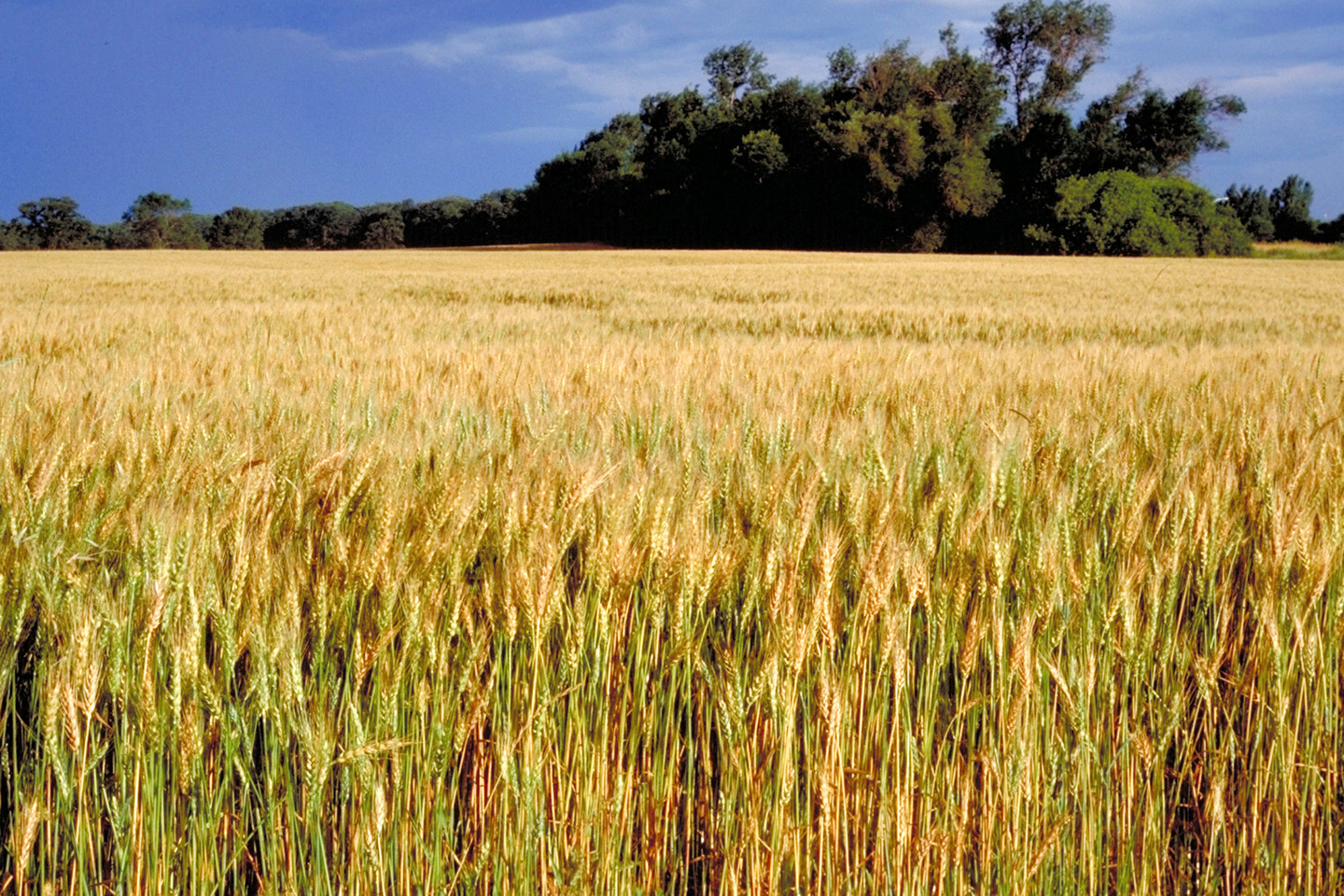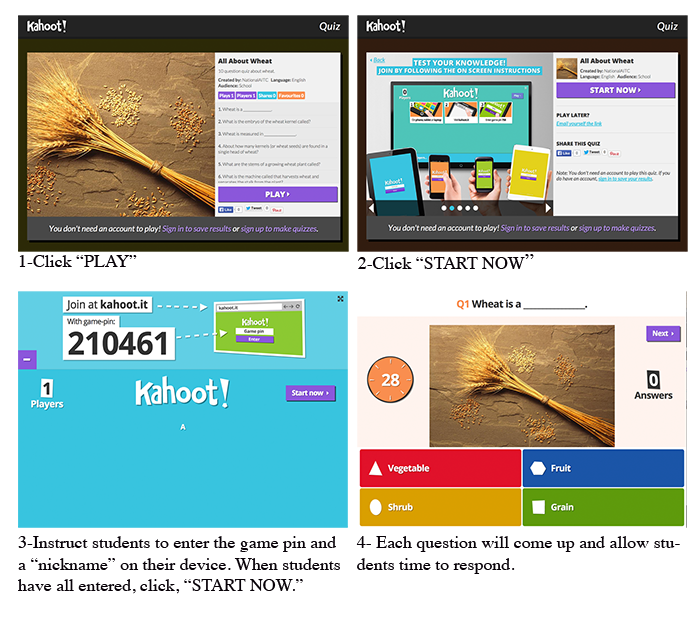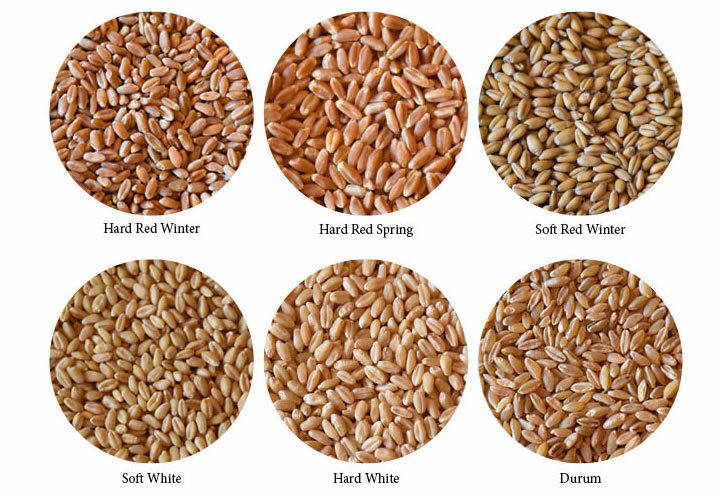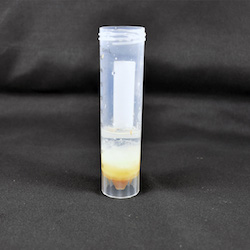 Relevancy and Engagement
massachusetts.agclassroom.org
Relevancy and Engagement
massachusetts.agclassroom.org
Wheat Germ DNA
Grade Level
Purpose
Using wheat as an example, students explore how DNA determines the genetic traits of a plant and how plant breeders change the DNA of a plant to produce desired characteristics. Grades 3-5
Estimated Time
Materials Needed
Engage:
Activity 1: All About Wheat
- Wheat Reader
- What Stuck? activity sheet
- Student iPads or smartphones with the "Kahoot" app loaded
- All About Wheat Kahoot
Activity 2: Classes of Wheat
- Stem of Wheat, 1 per student (Wheat stems can be obtained from a local farmer, or Wheat Bundles are available for purchase from agclassroomstore.com)
- How To Do IT! Threshing or Removing the Seed from the Plant handout
- Re-closable, clear plastic bag
- Samples of wheat—Hard Red Winter, Hard Red Spring, Soft Red Winter, Soft White, Hard White, and Durum, 1 sample per station* or Wheat Kernel Sample Images cut into vertical strips, 1 strip per student
- Hand lenses, minimum of 1 per station
- Wheat Information Cards, 1 card per station*
- Scissors, minimum 1 per station
- Glue sticks, minimum 1 per station
- Clear packing tape
- Six Classes of Wheat activity sheet, 1 set per student printed single-sided
- Products Made from Wheat images cut into vertical strips, 1 strip per student
- Interactive notebooks
*These items are included in the Wheat Kernel Samples Kit, which is available for purchase from agclassroomstore.com.
Activity 3: Wheat Germ DNA Extraction
- Wheat Kernel Dissection Image
- Fresh or vacuum-packed wheat germ
- Warm water (not boiled)
- Dish soap
- Isopropyl (rubbing) alcohol
- Test tubes, 1 per student*
- Stir sticks, 1 per student*
- Pipettes, 1 per student*
- Microcentrifuge tubes, 1 per student*
- Yarn, 1 necklace length piece per student*
- Safety glasses
- 1 teaspoon measuring spoon, minimum 1 per group
- 1 tablespoon measuring spoon, minimum 1 per group
- Wheat Germ DNA Extraction video
*These items are included in the Wheat Germ DNA Necklace Kit, which is available for purchase from agclassroomstore.com.
Activity 4:
- The Boy Who Changed the World, by Andy Andrews
Vocabulary
biotechnology: the use of living systems and organisms to develop or modify products or processes
deoxyribonucleic acid (DNA): deoxyribonucleic acid; a self-replicating material present in nearly all living organisms as the main constituent of chromosomes; the carrier of genetic information
embryo: a human, animal, or plant in the early stages of development before it is born, hatched, sprouted, etc.
gene: a unit of heredity that is transferred from a parent to offspring and is held to determine some characteristic of the offspring
genetic trait: a feature or quality that is passed on from one generation to the next in genes
genetically modified (GM): an organism or crop containing genetic material that has been artificially altered so as to produce a desired characteristic
germ: the embryo of a cereal grain seed
gluten: a tough, elastic protein substance in flour, especially from wheat, that holds dough together and makes it sticky
Green Revolution: beginning in the mid-20th century, a large increase in crop production in developing countries achieved by the use of fertilizers, pesticides, and high-yield crop varieties
plant breeder: a scientist that changes the traits of plants in order to produce desired characteristics
Did You Know?
- The Green Revolution refers to scientific technology that allowed researchers to create plants that grow in marginal areas. This technology helped feed the world by creating more grain for people in Mexico and third world countries, saving billions from starvation.1
- Wheat is grown in 42 states.2
- Besides flour and bread, other products from the wheat plant include straw particle board (wood) that is used in many kitchen cabinets, paper, hair conditioners, postage stamp adhesives, medical swabs, charcoal, and biodegradable plastic eating utensils.3
Background Agricultural Connections
When farmers make decisions about which varieties of wheat to plant, they are thinking about genetics. Each variety of wheat has DNA (deoxyribonucleic acid) that gives it certain genetic traits. In the wheat kernel, the DNA is located in the germ, which is the embryo or sprouting section of the seed. Some varieties of wheat grow better in drought conditions while others are better at resisting certain pests. Some wheat varieties have a higher moisture content or contain higher percentages of protein. These traits are important when considering the types of products that can best be produced by the flour of different classes of wheat.
American farmers grow six main classes of wheat—Hard Red Winter, Hard Red Spring, Soft Red Winter, Soft White, Hard White, and Durum. In addition to the time of year in which they are harvested, wheat classes are also determined by the hardness, shape, and color of the kernels. Hard wheats contain high levels of protein. Protein develops gluten which gives elasticity, structure, and strength to dough and creates a chewy texture in the finished product. These characteristics are important to the bread-making process. Soft wheat flour is ideal for making cakes, pastries, cookies, and crackers. The low protein levels create a flaky texture in the finished product. Durum wheat is a botanically separate species from the hard and soft wheat varieties. Its high protein content and gluten strength make it ideal for making pasta. The gluten levels make the dough firm and allows the pasta to hold its shape until it dries. Spring wheat is planted in the spring and harvested in the late summer or early fall. Winter wheat is planted in the fall and harvested in the spring.
Farmers decide which varieties to grow based on growing conditions in their area. They consider factors such as rainfall, temperature, soil condition, and customer preferences. Soft wheats grow best in humid areas where temperatures remain elevated throughout the night. Hard wheats require low humidity, hot daytime temperatures, and cool temperatures at night.
Norman Borlaug was a plant breeder who developed wheat varieties to help people get more food from their land. Borlaug's research was instrumental in the creation of faster-growing wheat varieties and other grains that withstood disease and drought. He introduced these varieties to people all over the world and taught them how to implement farming practices. Norman Borlaug received the Nobel Peace Prize in 1970 for his work that saved over a billion people from starvation in developing countries like Mexico, India, and Pakistan. Borlaug used traditional plant selection methods in his breeding programs. He was ahead of his time in creating varieties that caused the Green Revolution. His leading research achievement was the development of Dwarf Spring Wheat. Borlaug found that plants with stalks that were short and of equal length would receive equal amounts of sunlight when they did not have to compete with taller-stalked plants. Nature favors genes for tall stalks because, in nature, plants must compete for sunlight. Borlaug's dwarf wheat uses its energy to grow valuable grain rather than using its energy to grow tall stalks with no food value. Stout, short stalks also support wheat kernels better. Tall-stalked wheat may bend over at maturity, making it difficult to harvest.
Modern technology allows plant breeders to make precise genetic changes in order to address disease, insect, or environmental challenges more rapidly. Agricultural biotechnology is an advanced technology that allows plant breeders to identify the specific genes responsible for individual traits and transfer only the desired traits between plants. Currently, there is no genetically modified wheat seed available to farmers in the US.
Engage
- Show students the attached Picture of a Wheat Field. Ask students if they can name the crop.
- Once they have identified the wheat, ask them what wheat is used for. Brainstorm with your students and make a list on the board of all of the things they can think of that use wheat. (Share the Did you Know? Ag Facts)

Explore and Explain
Activity 1: All About Wheat
- Divide the class into groups of 3-5 students. Print 1 copy of the Wheat Reader for each group or individual student.
- Pass out the What Stuck? activity sheet to each student.
- Instruct the students to read the Wheat Reader and take notes about what they are learning on the "sticky notes" of the activity sheet.
- Increase the effectiveness of this reading strategy by first discussing with the students some of the things they will learn as they read.
- List the following questions on the board as a guide for the notes they should take on their activity sheet:
- What does a wheat plant look like?
- What is wheat used for?
- What are the parts of a wheat plant?
- What machines are used to plant and harvest wheat?
- When reading time is complete, review the basic information about wheat by playing the "All About Wheat" Kahoot game. Kahoot is a game-based classroom response system. First-time users will need to sign up for a free account. Kahoot can be used in the classroom with iPads, iPods, tablets, or smart phones. If individual student access is not available, classes can participate as a group by projecting the quiz on a screen.
- Follow the basic Kahoot instructions below or watch an online tutorial.

Activity 2: Classes of Wheat
- Using the instructions provided in the How To Do It! Threshing or Removing the Seed from the Plant handout, give each student the opportunity to thresh wheat by hand. When they are finished, they should have a small pile of wheat seeds, which should be put into a re-closable, clear plastic bag.
- Prepare six stations, each representing a class of wheat—Hard Red Winter, Hard Red Spring, Soft Red Winter, Soft White, Hard White, and Durum. Each station should include:
- A wheat kernel sample or kernel images from the attached Wheat Kernel Sample Images (if using kernel images, provide one image per student for each class of wheat)
- Hand lenses
- The corresponding Wheat Information Card
- Pencils
- Scissors
- Clear packing tape
- Glue sticks
- Organize the students into six groups. Provide each student with one copy of the Six Classes of Wheat activity sheet and one vertical strip of images from the Products Made From Wheat images.
- Explain to the students that there are six different classes of wheat grown in the United States. Each class has characteristics (traits) that determine the hardness, shape, and color of their kernels, what time of year their seeds are planted and harvested, which climates they grow best in, and what wheat products can best be made from their flour. For example, spring wheat is planted in the spring and harvested in the late summer or early fall. Winter wheat is planted in the fall and harvested in the spring.

- Tell the students that they are going to explore each of the six classes of wheat and record information about the traits of each class on their activity sheets.
- Instruct students to prepare their Six Classes of Wheat activity sheet by cutting on the dashed lines of the title page. Glue the left side of the title page (the section with the title "Six Classes of Wheat") onto the blank space on the left side of the second page. Fold back each of the six sections of the title page and crease on the solid line.
- Rotate the groups through the six stations. At each station, the students will complete the following steps:
- Read the information card.
- Observe the wheat kernel samples (or observe the kernel images) with the hand lenses.
- On the second page of the activity sheet, use clear packing tape to attach a few wheat kernels (or glue the kernel image) in the first empty box underneath the correct wheat class title strip.
- Record the hardness, shape, and color of the kernels.
- Cut out and glue the corresponding wheat product image in the second empty box. Record the products made from the wheat class.
- Record the US location(s) where the wheat class is grown.
- After the groups have completed all six stations, have the students attach their completed Six Classes of Wheat activity sheets into their interactive notebooks and meet together as a whole group to discuss the different characteristics of the six classes of wheat. Use information from the Background – Agricultural Connections and the following questions to guide the discussion:
- Which classes of wheat are most similar and why? (Hard Red Winter and Hard Red Spring wheat have the same hardness, shape, and color.)
- What is the difference between hard wheat and soft wheat? (Hard wheat contains a higher protein percentage than soft wheat. Protein develops gluten which gives elasticity, structure, and strength to dough. This is important to the bread-making process.)
- Is hard wheat or soft wheat better for making bread? (Hard wheat is better for making bread. The higher protein levels create a chewy texture.)
- Is hard wheat or soft wheat better for making cakes? (Soft wheat is better for making cakes. The lower protein levels create a flaky texture.)
- Which wheat is best for making dried pasta? (Due to its high protein content and gluten strength, Durum wheat is best for making dried pasta. The gluten levels make the dough firm and allows the pasta to hold its shape until it is dried.)
- What is the difference between spring wheat and winter wheat? (Spring wheat is planted in the spring and harvested in the late summer or early fall. Winter wheat is planted in the fall and harvested in the spring.)
- Can you identify which class of wheat you threshed at the beginning of this activity? (Note: If a Wheat Bundle was purchased from agclassroomstore, it is possible that a variety of wheat classes were mixed together. Students may or may not all have a wheat stem from the same class of wheat.)
Activity 3: Wheat Germ DNA Extraction
- Review the six classes of wheat and their characteristics with the students. Explain that each variety of wheat has DNA (deoxyribonucleic acid) that determines its specific genetic traits or characteristics.
- Project the Wheat Kernel Dissection Image on a large screen. Point out the germ. Explain that the germ of the wheat kernel, which is the embryo or sprouting section of the seed, contains the DNA. When the embryo sprouts and grows into a plant, the specific traits will be expressed in the plant. (For a more in-depth study of the parts of a wheat kernel, refer to the lesson Enjoying the Harvest.)
- Tell the students that they are going to extract (remove) DNA from wheat germ so that they can observe the DNA strands that contain the traits of the wheat.
- Organize students into small groups. Provide each student with one test tube, one stir stick, one pipette, one microcentrifuge tube, one necklace-length piece of yarn, and a pair of safety glasses. Provide each group with warm water, dish soap, rubbing alcohol, a teaspoon measuring spoon, and a tablespoon measuring spoon.
- Refer to the Wheat Germ DNA Extraction video for a demonstration of the process.

- Guide the students through the following instructions:
- Pour 1/4 teaspoon of wheat germ into the test tube.
- Add 2 teaspoons of warm water and mix with the stir stick.
- Add 4 drops of dish soap and mix.
- Let the solution stand for 5 minutes. Use this time for students to discuss their predictions within their groups.
- After the 5 minutes are up, put safety glasses on, tip the test tube slightly and slowly run 1 tablespoon of rubbing alcohol down the side of the tube until it is half full. It is important that the alcohol is slowly added to the solution to avoid stirring up the wheat germ flakes. The rubbing alcohol will precipitate the DNA (cause the DNA to come out of the wheat germ solution).
- Observe the line between the wheat germ solution and the alcohol. You will notice a white, thread-like cloud appearing above this line. This is the wheat germ DNA.
- Use the pipette to carefully collect the cloudy clumps of DNA strands and transfer them to the microcentrifuge tube.
- Close the cap of the microcentrifuge tube tightly around a piece of yarn and tie the ends of the yarn to make a DNA necklace.
- Ask the students to make observations about the wheat germ DNA. Use the following questions to guide the discussion:
- What does DNA look like? Did it match your prediction?
- Why is it useful for scientists to be able to extract DNA from an organism?
- Why is it important for farmers to understand the genetic traits of the crops they grow and the animals they raise?
Activity 4: The Boy Who Changed the World

- Discuss the importance of wheat as a staple food product. Explain that wheat can be successfully grown in many different areas of the world and can provide needed nourishment for many people.
- Read the book, The Boy Who Changed the World by Andy Andrews.
- Discuss the contribution Norman Borlaug made to the worldwide efforts against hunger. Use the following questions to guide the discussion:
- How did Norman Borlaug change the world? (He created special seeds that grew into super plants that could feed more people around the world.)
- How many people did the work of Norman Borlaug save from starvation? (two billion people)
- Why was it important for Norman Borlaug to learn everything he could about plants and the genetic traits of crops? (Norman Borlaug needed to know about plants and genetic traits so that he could create seeds that had specific traits to grow fast, avoid disease, and grow in different areas of the world.)
Elaborate
-
View the video Norman Borlaug & the Green Revolution to learn more about Norman Borlaug's work with wheat.
-
Visit the Interactive Map Project website and view the map representing Wheat Production in the United States. Identify the states that produce the most wheat and then find where your state ranks for wheat production.
Evaluate
After conducting these activities, review and summarize the following key concepts:
- There are six different classes of wheat grown in the United States. Each class has specific characteristics (traits).
- Each variety of wheat has DNA (deoxyribonucleic acid) that determines its specific genetic traits or characteristics.
- The germ of the wheat kernel, which is the embryo or sprouting section of the seed, contains the DNA.
- Norman Borlaug was a plant breeder who used his knowledge of plants and DNA to develop faster-growing wheat varieties that withstand disease and drought.
Sources
- https://en.wikipedia.org/wiki/Green_Revolution
- http://www.idahowheat.org/education/wheat-facts.aspx
- http://www.dimpflmeierbakery.com/five-fun-facts-wheat/
Recommended Companion Resources
- America's Heartland: Wheat Episodes
- Bread Comes to Life
- Bread Lab!
- DNA Learning Center
- Everybody Bakes Bread
- Garden Genetics: Teaching With Edible Plants
- Hero for the Hungry: The Life and Work of Norman Borlaug
- How to Extract DNA from Anything Living
- Let's Get Growing!
- Still There Was Bread
- Strawberry DNA Necklace
- The Boy Who Changed the World
- The Wheat Doll
- Wheat Bundle
- Wheat Germ DNA Necklace
- Wheat Kernel Samples
- Who Made My Lunch? From Wheat to Bread